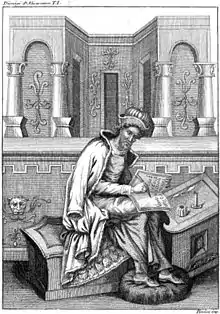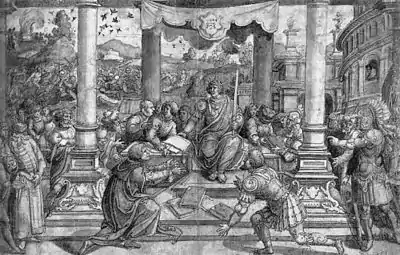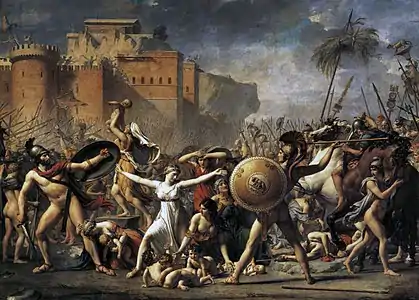Dionysius of Halicarnassus
Dionysius of Halicarnassus (Greek: Διονύσιος Ἀλεξάνδρου Ἁλικαρνασσεύς, Dionúsios Alexándrou Halikarnasseús, ''Dionysios son of Alexandros of Halikarnassos''; c. 60 BC – after 7 BC) was a Greek historian and teacher of rhetoric, who flourished during the reign of Augustus Caesar. His literary style was Atticistic—imitating Classical Attic Greek in its prime.

Dionysius' opinion of the necessity of a promotion of paideia within education, from true knowledge of classical sources, endured for centuries in a form integral to the identity of the Greek elite.[1]
Life
He was a Halicarnassian.[1] At some time he moved to Rome after the termination of the civil wars, and spent twenty-two years studying Latin and literature and preparing materials for his history.[2] During this period, he gave lessons in rhetoric, and enjoyed the society of many distinguished men. The date of his death is unknown.[3] In the 19th century, it was commonly supposed that he was the ancestor of Aelius Dionysius of Halicarnassus.[4]
Works
His major work, entitled Rhōmaïkḕ Arkhaiología (Ῥωμαϊκὴ Ἀρχαιολογία, ''Roman Antiquities''), embraced the history of Rome from the mythical period to the beginning of the First Punic War. It was divided into twenty books, of which the first nine remain entire, the tenth and eleventh are nearly complete, and the remaining books exist in fragments,[5] in the excerpts of the Roman emperor Constantine Porphyrogenitus and an epitome discovered by Angelo Mai in a Milan manuscript. The first three books of Appian, Plutarch's Life of Camillus and Life of Coriolanus also embody much of Dionysius.
Outline of “Roman antiquities “ with chronological where possible.
Book I. Mythological history of Italy and its people ending with the death of Remus BCE (1300?)-753. Book II. The start of Roman monarchy and its first two Kings, Romulus and Numa Pompilius BCE 753-673. Romulus customs and laws for Rome Sabine war- the combat is described with numerous officers , thousands of infantry ,and cavalry combatants. The real Rome of 8th century BCE was a tiny village that possibly participated in small scale raids with neighbors. Book III. King Tullus Hostilius through King Lucius Tarquinius Priscus BCE 673-575. Book IV. Last of the Roman kings and end to the monarchy with overthrow of Tarquinius Superbus BCE 575-509. Book V. Start of Roman Republic and Consular years BCE 509-497. Book VI. BCE 496-493. Book VII. BCE 492-490. Book VIII. BCE 489- 482. Book IX. BCE 481-462. Book X. BCE 461- 449 The decemverite.
Note- last ten books only remain in fragments. Except Book 11 has substantial extant material remaining.
Book 11. BCE 449-443. Book 12. BCE 442- 396. Book 13. BCE 394- 390. Book 14. Gauls and the BCE 390 sack of Rome. Book 15. First and second samnite war. Book 16. Third samnite war. Book 17/18. Third samnite war. Book 19. The city of Tarentum and the beginning of Roman pyrrhic war. Book 20. Roman-Pyrrhic war, with Pyrrhus’s second invasion of Italy.
His chief object was to reconcile the Greeks to the rule of Rome, by dilating upon the good qualities of their conquerors and also by arguing, using more ancient sources, that the Romans were genuine descendants of the older Greeks.[6][7] According to him, history is philosophy teaching by examples, and this idea he has carried out from the point of view of a Greek rhetorician. But he carefully consulted the best authorities, and his work and that of Livy are the only connected and detailed extant accounts of early Roman history.[8]
Dionysius was also the author of several rhetorical treatises, in which he shows that he has thoroughly studied the best Attic models:
- The Art of Rhetoric (Τέχνη ῥητορική, Tékhnē rhētorikḗ), which is rather a collection of essays on the theory of rhetoric, incomplete, and certainly not all his work;
- The Arrangement of Words (Περὶ συνθέσεως ὀνομάτων, Perì sunthéseōs onomátōn, Latin: De compositione verborum), treating of the combination of words according to the different styles of oratory;
- On Imitation (Περὶ μιμήσεως, Perì mimḗseōs), on the best models in the different kinds of literature and the way in which they are to be imitated—a fragmentary work;
- Commentaries on the Attic Orators (Περὶ τῶν Ἀττικῶν ῥητόρων, Perì tôn Attikôn rhētórōn), which, however, only deal with Lysias, Isaeus, Isocrates and (by way of supplement) Dinarchus;
- On the Admirable Style of Demosthenes (Περὶ λεκτικῆς Δημοσθένους δεινότητος, Perì lektikês Dēmosthénous deinótētos); and
- On the Character of Thucydides (Περὶ Θουκιδίδου χαρακτῆρος, Perì Thoukidídou kharaktêros).
The last two treatises are supplemented by letters to Gn. Pompeius and Ammaeus (two, one of which is about Thucydides).[3]
Dionysian imitatio
Dionysian imitatio is the literary method of imitation as formulated by Dionysius, who conceived it as the rhetorical practice of emulating, adapting, reworking, and enriching a source text by an earlier author.[9][10] It shows marked similarities with Quintilian’s view of imitation, and both may derive from a common source.[11]
Dionysius' concept marked a significant departure from the concept of mimesis formulated by Aristotle in the 4th century BC, which was only concerned with "imitation of nature" and not "imitation of other authors."[9] Latin orators and rhetoricians adopted Dionysius' method of imitatio and discarded Aristotle's mimesis.[9]
History in the Roman Antiquities, and the Foundation Myth
Dionysius carried out extensive research for his Roman history, selecting among authorities, and preserving (for example) details of the Servian Census.[12]
His first two books present a unified account of the supposed Greek origin for Rome, merging a variety of sources into a firm narrative: his success, however, was at the expense of concealing the primitive Roman actuality (as revealed by archaeology).[13] Along with Livy,[14] Dionysius is thus one of the primary sources for the accounts of the Roman foundation myth, and that of Romulus and Remus, and was relied on in the later publications of Plutarch, for example. He writes extensively on the myth, sometimes attributing direct quotations to its figures. The myth spans the first 2 volumes of his Roman Antiquities, beginning with Book I chapter 73 and concluding in Book II chapter 56.
Origins and survival in the wild
Dionysius claims that the twins, Romulus and Remus, were born to a vestal named Ilia Silvia (sometimes called Rea), descended from Aeneas of Troy and the daughter of King Latinus of the Original Latin tribes, thus linking Rome to Trojans and Latins both. Dionysius lays out the different accounts of her pregnancy and the twins' conception, but declines to choose one over the others.
Citing Fabius, Cincius, Porcius Cato, and Piso, Dionysius recounts the most common tale, whereby the twins are to be tossed into the Tiber; are left at the site of the ficus Ruminalis; and rescued by a she-wolf who nurses them in front of her lair (the Lupercal). Dionysius relates an alternate, "non-fantastical" version of Romulus and Remus' birth, survival and youth. In this version, Numitor managed to switch the twins at birth with two other infants. The twins were delivered by their grandfather to Faustulus to be fostered by him and his wife, Laurentia, a former prostitute. According to Plutarch, lupa(Latin for "wolf") was a common term for members of her profession and this gave rise to the she-wolf legend.
Education, and Foundation of Rome
The twins receive a proper education in the city of Gabii, before eventually winning control of the area around where Rome would be founded. Dispute over the particular hill upon which Rome should be built, the Palatine Hill or the Aventine Hill for its strategic advantages saw the brothers fall out and Remus killed.
Before construction on the city began Romulus made sacrifices and received good omens, and he then ordered the populace to ritually atone for their guilt. The city's fortifications were first and then housing for the populace. He assembled the people and gave them the choice as to what type of government they wanted - monarchy, democracy, or oligarchy - for its constitution.[15] After his address, which extolled bravery in war abroad and moderation at home, and in which Romulus denied any need to remain in power, the people decided to remain a kingdom and asked him to remain its king. Before accepting he looked for a sign of the approval of the gods. He prayed and witnessed an auspicious lightning bolt, after which he declared that no king shall take the throne without receiving approval from the gods.
Institutions
Dionysus then provided a detailed account of the ‘Romulus’ constitution, most probably based on the work of Terentius Varro.[16] Romulus supposedly divides Rome into 3 tribes, each with a Tribune in charge. Each tribe was divided into 10 Curia, and each of those into smaller units. He divided the kingdoms land holdings between them, and Dionysus alone among our authorities insists that this was done in equal lots.[17] The Patrician class was separated from the Plebeian class; while each curiae was responsible for providing soldiers in the event of war.

A system of patronage (clientela), a senate (attributed by Dionysius to Greek influence) and a personal bodyguard of 300 of the strongest and fittest among the nobles were also established: the latter, the celeres, were so-named either for their quickness, or, according to Valerius Antias, for their commander.[18]
A Separation of power,[14.1-3] and measures to increase manpower,[15-17] were also instituted, as were Rome's religious customs and practices[18-23], and a variety of legal measures praised by Dionysus.
Again, Dionysius thoroughly describes the laws of other nations before contrasting the approach of Romulus and lauding his work. The Roman law governing marriage is, according to his Antiquities, an elegant yet simple improvement over that of other nations, most of which he harshly derides. By declaring that wives would share equally in the possessions and conduct of their husband, Romulus promoted virtue in the former and deterred mistreatment by the latter. Wives could inherit upon their husband's death. A wife's adultery was a serious crime, however, drunkenness could be a mitigating factor in determining the appropriate punishment. Because of his laws, Dionysius claims that not a single Roman couple divorced over the following five centuries.
Romulus' laws governing parental rights, in particular, those that allow fathers to maintain power over their adult children were also considered an improvement over those of others; while Dionysius further approved of how, under the laws of Romulus, native-born free Roman's were limited to two forms of employment: farming and the army. All other occupations were filled by slaves or non-Roman labor.
Romulus used the trappings of his office to encourage compliance with the law. His court was imposing and filled with loyal soldiers and he was always accompanied by the 12 lictors appointed to be his attendants.
Sabine women, and death of Romulus

Following his institutional account, Dionysus described the famous abducting of the Sabine women, stressing particularly how they were to be married according to their own Sabine customs,[19] and suggesting thereby that the abduction was a pretext for alliance with the Sabines.[20] In his narrative, however, the cities of Caecina, Crustumerium, and Antemnae petition for Tatius, king of the Sabines to lead them to war; and it is only after the famous intervention of the Sabine women that the nations agreed to become a single kingdom under the joint rule of Romulus and Tatius, both declared Quirites.
After the death of Tatius, however, Romulus became more dictatorial, until he met his end, either through actions divine or earthly.
Editions
- Collected Works edited by Friedrich Sylburg (1536–1596) (parallel Greek and Latin) (Frankfurt 1586) (available at Google Books)
- Complete edition by Johann Jakob Reiske (1774–1777)[21]
- Archaeologia by A. Kiessling (1860-1870) (vol. 1, vol. 2, vol. 3, vol. 4) and V. Prou (1886) and C. Jacoby (1885–1925) (vol. 1, vol. 2, vol. 3, vol. 4, supplementum) [21]
- Opuscula by Hermann Usener and Ludwig Radermacher (1899-1929)[21] in the Teubner series (vol. 1 contains Commentaries on the Attic Orators, Letter to Ammaeus, On the Admirable Style of Demosthenes, On the Character of Thucydides, Letter to Ammaeus about Thucydides, vol. 2 contains The Arrangement of Words, On Imitation, Letter to Gn. Pompeius, The Art of Rhetoric, Fragments)
- Roman Antiquities by V. Fromentin and J. H. Sautel (1998–), and Opuscula rhetorica by Aujac (1978–), in the Collection Budé
- English translation by Edward Spelman (1758) (available at Google Books)
- Trans. Earnest Cary, Harvard University Press, Loeb Classical Library:
- Roman Antiquities, I, 1937.
- Roman Antiquities, II, 1939.
- Roman Antiquities, III, 1940.
- Roman Antiquities, IV, 1943.
- Roman Antiquities, V, 1945.
- Roman Antiquities, VI, 1947.
- Roman Antiquities, VII, 1950.
- Trans. Stephen Usher, Critical Essays, I, Harvard University Press, 1974, ISBN 978-0-674-99512-3
- Trans. Stephen Usher, Critical Essays, II, Harvard University Press, 1985, ISBN 978-0-674-99513-0
References
- Hidber, T. (31 Oct 2013). Wilson, N. (ed.). Encyclopedia of Ancient Greece(p.229). Routledge. p. 229. ISBN 978-1136787997. Retrieved 2015-09-07.
- J E Sandys, A Dictionary of Classical Antiquities (London 1894 p. 190
-
 One or more of the preceding sentences incorporates text from a publication now in the public domain: Chisholm, Hugh, ed. (1911). "Dionysius Halicarnassensis". Encyclopædia Britannica. 8 (11th ed.). Cambridge University Press. pp. 285–286.
One or more of the preceding sentences incorporates text from a publication now in the public domain: Chisholm, Hugh, ed. (1911). "Dionysius Halicarnassensis". Encyclopædia Britannica. 8 (11th ed.). Cambridge University Press. pp. 285–286. - Schmitz, Leonhard (1867), "Dionysius, Aelius", in Smith, William (ed.), Dictionary of Greek and Roman Biography and Mythology, 1, Boston, p. 1037
- J E Sandys, A Dictionary of Classical Antiquities (London 1894 p. 190
- The Roman Antiquities of Dionysius of Halicarnassus. I (Loeb Classical Library ed.). Chicago: University of Chicago. March 29, 2018 [1937].
- Gabba, E. (1991), Dionysius and the History of Archaic Rome. Berkeley.
- S Usher, The Historians of Greece and Rome (London 1969) p. 240-1
- Ruthven (1979) pp. 103–4
- Jansen (2008)
- S F Bonner, The Literary Treatises of Dionysius of Halicarnassus (2013) p. 39
- S Usher, The Historians of Greece and Rome (London 1969) p. 239
- S Usher, The Historians of Greece and Rome (London 1969) p. 241
- J Burrow, A History of Histories (Penguin 2009) p. 101 and 116
- T P Wiseman, Remembering the Roman Republic (2011) p. xviii-ix
- T P Wiseman, Remembering the Roman Republic (2011) p. xviii
- T P Wiseman, Remembering the Roman Republic (2011) p. xviii
- T P Wiseman, Remembering the Roman Republic (2011) p. ii
- G Miles, Livy (2018) p. 197
- R Hexter ed., Innovations of Antiquity (2013) p. 164
- Chisholm 1911.
Further reading
- Bonner, S. F. 1939. The literary treatises of Dionysius of Halicarnassus: A study in the development of critical method. Cambridge, UK: Cambridge Univ. Press.
- Damon, C. 1991. Aesthetic response and technical analysis in the rhetorical writings of Dionysius of Halicarnassus. Museum Helveticum 48: 33–58.
- Dionysius of Halicarnassus. 1975. On Thucydides. Translated, with commentary, by W. Kendrick Pritchett. Berkeley and London: Univ. of California Press.
- Gabba, Emilio. 1991. Dionysius and the history of archaic Rome. Berkeley: Univ. of California Press.
- Gallia, Andrew B. 2007. Reassessing the 'Cumaean Chronicle': Greek chronology and Roman history in Dionysius of Halicarnassus. Journal of Roman Studies 97: 50–67.
- Jonge, Casper Constantijn de. 2008. Between Grammar and Rhetoric: Dionysius of Halicarnassus On Language, Linguistics and Literature. Leiden: Brill.
- Jonge, Casper C. de, and Richard L. Hunter (ed.). 2018. Dionysius of Halicarnassus and Augustan Rome. Cambridge: Cambridge University Press.
- Sacks, Kenneth. 1986. Rhetoric and speeches in Hellenistic historiography. Athenaeum 74: 383–95.
- Usher, S. 1974–1985. Dionysius of Halicarnassus: The critical essays. 2 vols. Cambridge, MA, and London: Harvard Univ. Press.
- Wiater, N. 2011. The ideology of classicism: Language, history and identity in Dionysius of Halicarnassus. Berlin and New York: De Gruyter.
- Wooten, C. W. 1994. The Peripatetic tradition in the literary essays of Dionysius of Halicarnassus. In: Peripatetic rhetoric after Aristotle. Edited by W. W. Fortenbaugh and D. C. Mirhady, 121–30. Rutgers University Studies in Classical Humanities 6. New Brunswick, NJ: Transaction.
External links
| Library resources about Dionysius of Halicarnassus |
| By Dionysius of Halicarnassus |
|---|